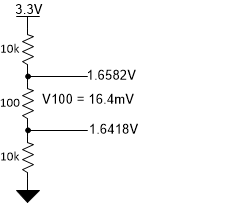Dear experts,
I am working with NXP™ LPC2138 Microcontroller and AD converter ads1231. Now I am facing with a problem: the input signal Vin is different with the value that I calculate with the formula from datasheet.
My setup:
Verfp: +3.3v
Vrefn: 0v(GND)
Voltage 3.3v is divided with a 20k and a 100ohm resistor. Range of thermistor is 0 to 100 ohm. Same divided resistor is connected with thermistor. So a comparative voltage is provided with the output of thermistor. They are connected to AINN and AINP respectively.
The formula proviede by datasheet is: (0.5VREF/128)/0x7fffff. That is: Vin=x*((0.5VREF/128)/0x7fffff). x is the data read from ads1231, VREF is 3.3v.
While I debuging application, I read a value 919001 from ads1231. Using the formula above, I get the result 1.4mV. But the real Voltage at AINN is 0.0175, Voltage at AINP is 0.0463. Difference of them is 0.0288. The difference with the result from formula is about 20 times! What wrong I do? Please tell me. Thank you!
Best regards
John



